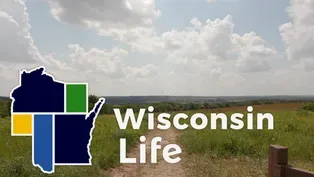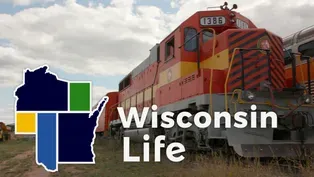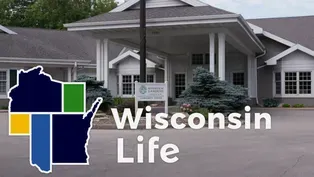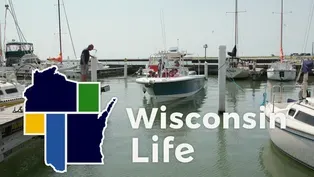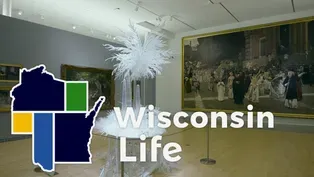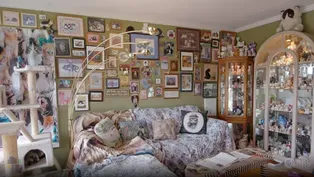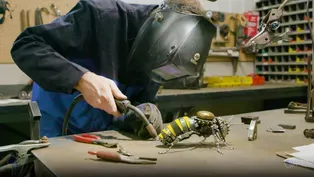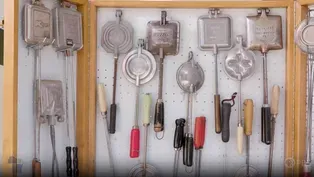
Willow River State Park in Hudson
Season 10 Episode 4 | 26m 48sVideo has Closed Captions
Explore Willow River State Park’s stunning waterfall, serene lake and endless trails.
At Willow River State Park, Angela Fitzgerald explores the park’s popular waterfall, serene lake, and endless hiking trails that welcome close to 1 million visitors a year. Meet a couple in Menomonee Falls celebrating furry felines with an enormous cat collection, and we visit Kohler-Andrae State Park in Sheboygan to meet the Pudgy Pie Guy.
Problems with Closed Captions? Closed Captioning Feedback
Problems with Closed Captions? Closed Captioning Feedback
Wisconsin Life is a local public television program presented by PBS Wisconsin
Funding for Wisconsin Life is provided by the Wooden Nickel Fund, Mary and Lowell Peterson, A.C.V. and Mary Elston Family, Obrodovich Family Foundation, Stanley J. Cottrill Fund, Alliant Energy, UW...

Willow River State Park in Hudson
Season 10 Episode 4 | 26m 48sVideo has Closed Captions
At Willow River State Park, Angela Fitzgerald explores the park’s popular waterfall, serene lake, and endless hiking trails that welcome close to 1 million visitors a year. Meet a couple in Menomonee Falls celebrating furry felines with an enormous cat collection, and we visit Kohler-Andrae State Park in Sheboygan to meet the Pudgy Pie Guy.
Problems with Closed Captions? Closed Captioning Feedback
How to Watch Wisconsin Life
Wisconsin Life is available to stream on pbs.org and the free PBS App, available on iPhone, Apple TV, Android TV, Android smartphones, Amazon Fire TV, Amazon Fire Tablet, Roku, Samsung Smart TV, and Vizio.
Providing Support for PBS.org
Learn Moreabout PBS online sponsorshipMore from This Collection
Blackhawk Ski Club in Middleton
Video has Closed Captions
We explore the competitive side of winter sports with the Blackhawk Ski Club in Middleton. (26m 48s)
Holi Festival of Colors in Wausau
Video has Closed Captions
We celebrate the Holi Festival of Colors at the Monk Botanical Gardens in Wausau. (26m 49s)
Retzer Nature Center in Waukesha
Video has Closed Captions
Angela visits the wild side of Waukesha at the Retzer Nature Center and planetarium. (26m 48s)
Wisconsin Great Northern Railroad in Trego
Video has Closed Captions
All aboard the Wisconsin Great Northern Railroad for a historic ride in the Northwoods. (26m 48s)
Video has Closed Captions
We tour Riverview Gardens in Appleton, a non-profit offering job training and employment. (26m 48s)
Sailing Education Association of Sheboygan
Video has Closed Captions
We learn about adaptive sailing with SEAS, the Sailing Education Association of Sheboygan. (26m 48s)
Museum of Wisconsin Art in West Bend
Video has Closed Captions
Celebrate artists in our state at MOWA, Museum of Wisconsin Art in West Bend. (26m 49s)
Providing Support for PBS.org
Learn Moreabout PBS online sponsorship- Announcer: The following program is a PBS Wisconsin Original Production.
- Angela: Coming up on "Wisconsin Life..." a couple with a collection that's the cat's meow, [gentle music] a professor sharing stories from her dynamic career, [gentle, upbeat music] an artist welding wonders out of metal, [drill whirring] and we meet the Pudgy Pie Guy!
That's all ahead on "Wisconsin Life."
[bright, upbeat music] - Announcer: Funding for "Wisconsin Life" is provided by Lowell and Mary Peterson, Alliant Energy, donors to the Focus Funds for Wisconsin Programs, and Friends of PBS Wisconsin.
- Hi, I'm Angela Fitzgerald, and this is "Wisconsin Life."
Today, we're flowing through the magnificent Willow River State Park, home of this stunning waterfall, a large selection of hiking trails, and a variety of scenic gems.
The park sits close to the Wisconsin border in Hudson and covers nearly 3,000 acres.
And there's plenty of ways to take it all in, from rock climbing, camping, to swimming.
The most popular destination in the park is the cascading waterfall, that has its own deep history to dive into.
Indigenous people used the river as a natural resource before it was occupied by settlers for logging and agriculture in the 1800s.
German immigrant Christian Burkhardt built a hydroelectric dam that powered the city now called Hudson.
The power plant operated until the 1960s.
And it wasn't until 1971 that Willow River State Park opened.
Even as a state park, it took a number of years for the dams to be removed.
As the area was restored, the river and surrounding land has gained much of its natural beauty back.
Now, visitors can trek their way to see one of Wisconsin's most scenic riverscapes.
[water rushing] Before I dip my feet in, let's plunge into our first set of stories... as we travel to Freedom, where an artist is crafting creatures out of metal.
[soft rhythmic music] For many, finding inspiration can be a bit of a puzzle.
[pulley rattling] [junk clinking] - David Groenjes: My past job, when I was at work, I was always thinking about what I wanted to do, but when I got home, I didn't have enough energy to be inspired.
And so, now I wake up with energy every day, and I get to go put it to use immediately.
- Angela: But if you look long and hard enough... [junk pieces clanking] - David: And I'll dump pieces out all over the floor.
- Angela: Things start fitting into place.
[gentle, rhythmic music] - There's a lot of times it just doesn't fit, and you'll take a piece, and then, you'll find where it fits.
And I'll get pieces here and there, and then, I kind of fill it in, in the middle.
[sparks crackling] - Angela: It's that puzzle-solving mentality that artist David Groenjes uses to spark his creations.
[drill whirring] - David: And I mainly do wildlife art.
I like pieces that have neat curves and shapes, an organic feel to 'em.
[sparks crackling] - Angela: He's created hundreds upon hundreds of metal sculptures.
[gentle music] Every piece wields its own special bond, making it difficult to pick a favorite.
[gentle, rhythmic music] - Gosh, you know, every time I make one, a lot of times I make one, I say it's my favorite, but then I make another one, and then the next one's my favorite, so... [laughing softly] [gentle, rhythmic music] - Angela: Although David struggles to pick a favorite, he does prefer sculpting one subject over others.
- I like doing insects.
And so, I'll see a really cool insect or a bee.
Sometimes, it's just based on things my kids have seen, and sometimes it's just, I don't know where it comes from, you know?
And I love making spiders.
And I knew that I needed something that was gonna be different from anything I've ever done before.
So, I remember the movie, "The Wild, Wild West," and there was this big steampunk monster spider thing they were riding around in.
And so, I wanted to make something that kinda reminded me of that.
And that's where that came from.
[gentle, rhythmic music] [sanding] - Angela: David prides himself on using materials that normally would either rust away or live forever in a scrap pile.
- Everything I use is, for the most part, cast iron, mild steel, or stainless steel.
And I try to use as much recycled or reclaimed material as possible.
So, I'd say about 90% to 95% of my materials is waste product from some either old pieces of equipment, old car parts, tractor parts, or industrial waste from factories.
I've got a horse that I named Oliver because there's a great big hunk of iron on it that's part of an Oliver plow that's probably over a hundred years old.
And it's just really cool to have the history behind it.
I love the fact that I can take material that would just get thrown in the garbage or rot away in a field.
You know, some of it gets recycled, but I can take it and give it new life.
[gentle, rhythmic music] - Angela: With most puzzles, you don't see the full picture until everything is pieced together.
[gentle, rhythmic music] David, however, likes to leave a few pieces missing, giving others the opportunity to complete the puzzle themselves.
- David: I like to take things where your mind has to kind of put the rest of it together.
Taking pieces that have a texture that could look like a feather or look like fur.
Or maybe making a sculpture that has a lot of negative space where half the sculpture you're looking through to the background and the rest of it is material.
And letting your mind kind of fill in the pieces.
[junk pieces rattling] - Angela: If life is a puzzle, for David, art is a large piece of his.
He needed some help solving it at first.
But once he did, everything else just seemed to, well, fit.
- When I decided I was gonna do this, I had a lot of positive encouragement from my friends and family.
The biggest obstacle that I had to overcome was holding myself back.
[drill whirring] My life was great, but I know I'd be missing something.
You know, what I've gained, the things I'm learning, it allows me to think outside the box a lot.
I think that constant activity of thinking things like that helps me.
Everyone along the way really encouraged me to do what I wanted to do, and I'm very grateful for that.
[gentle, rhythmic music] [shimmery music] - Angela: Next, we head to Menomonee Falls, where a couple is building a "purr"fect collection of furry felines.
[playful, plucky strings] - It started as just, let's pick up some cats for fun and decorate our house.
[plucky strings] - Then there's more cats and more cats.
Pretty soon, we're driving for cats.
- Angela: Shawn Redner and Hilary Siegel-Redner hope to have a cat collection like no other.
[door closes, ignition catches] - Hilary: We travel all over the state of Wisconsin.
We've driven up to Ohio and Iowa.
- I saw cats for sale in Peoria, so we're going to Peoria.
Everywhere I go, I'm always looking for cats.
- Angela: Shawn is the one who came up with the idea.
- No, she was not on board.
- I was not on board.
[laughing] When he first said it, I go, "We're doing what?!"
He goes, "Yeah, let's go collect some cats and have some fun."
- I'm kind of cat-obsessed.
- Yes.
- Shawn: That's Squeaky.
And this is Bear.
- The license plate on his vehicle is CATMN.
[bright rock music] - Angela: They've been collecting cats since 2020.
- Hilary: 90% Of the figurines come from thrift stores.
- Shawn: I can scan a shelf from 20 feet and see what looks like a cat.
- If we know that that price is a little too high, we feel bad, but we leave the cat behind.
Otherwise, if it's something meaningful, something cool, something different, then it's definitely in our budget whether we can afford it or not.
[laughing] - Angela: Three years later, nearly every inch of their home is covered by cats.
- So, [chuckles] right now, our house is completely full.
- Angela: Their house in Menomonee Falls, the one with 'MEOW' on the front, is now Redner's Rescued Cat Figurine Museum.
- 'Cuz this is a museum.
We just sleep here.
- Pretty much.
- That's pretty much it.
Until you come see it for yourself, it is only then when you realize what I'm talking about.
- Angela: Everyone can realize what Shawn's talking about on the third Sunday of each month when the museum opens for tours.
- The tours are amazing.
- That was the very first thing that we bought, and we had no intention of the museum happening.
- If it's a cat, we have it here at the museum.
- All these cats were found in their frames at various secondhand shops, and if they were loved once, we can bring 'em home and love 'em again.
It's just like a little escape from the world 'cause we need more things to make more people happy.
[cat chirps, purrs] - Angela: With so much love to give, these figurine fanciers actually lost track of how many cat collectibles they've acquired.
- I'm gonna say in this house, there's probably roughly about 4,000.
- Oh, no.
- Would be a guess.
- I would say roughly 5,000.
I'm gonna go up a thousand from him because on my off time, I did count.
However, as of last night, we added a lot more.
- They'll need to keep adding to reach the Guinness Book of World Records.
- I should research that a little more because that is something I would like to break.
- Angela: The record?
21,300 unduplicated cat items.
- Shawn: I think we're about a quarter of the way there.
- Angela: The goal now?
Moving the cats to a permanent location that includes a coffee shop where resident felines can be adopted.
- We know that there's a big cat population that needs help, especially the shelters that try to take care of them.
- That's when the idea for the museum came as using it as a vehicle to help raise money for the cat rescues around the Milwaukee area.
- Hilary and Shawn have eight rescued cats of their own.
- Come on, kitties.
[making kissy sounds] Come on, Panda.
Come on, Jack.
[hearty meow] Oh, there he is.
[cat chirps, meows] - Angela: Furry friends and fragile figurines don't always mix.
- This is the only room in the house the cats are not allowed into.
I gotta show you this.
This is Kashka.
She's from Kazakhstan.
She is probably one of my favorite ones.
She's very elegant.
I know that's weird, but she's phenomenal.
- Angela: They want the museum to become a favorite destination for cat lovers.
- Hilary: It's unique.
No one is gonna have a house filled with cat stuff and different kind of cat art on our walls.
And why not?
I know how much it meant to him, and so, I went along with it.
It's cool.
It's very cool.
- If we can get the café, and the Guinness Book of World Records, and the museum all in one building, I will have the world's greatest cat figurine museum.
[warm, snappy rhythm] [shimmery music] - We're checking out Willow River in Hudson to discover why the state park continues to be a beloved and popular destination.
[water rushing] [rhythmic piano, guitar, and drums] A fast-flowing waterfall.
Serene lake views.
And tranquil trails.
Park Superintendent Aaron Mason knows this land well.
- Now, Willow River State Park, we're about 3,000-acre property.
We have camping, hiking trails, single-track bike trails.
There's a waterfall, is probably our main feature that people come here to see.
We have three family campgrounds and a group campground for about 154 campsites.
There is a ton of stuff to do here.
Fishing, canoeing, kayaking.
The Little Falls Lake is a 172-acre non-motorized lake.
[upbeat piano, acoustic, and drums] [water rushing] So, the waterfall is obviously extremely popular.
It is pretty shallow.
It is kind of slippery, but a lot of people will climb through the waterfall, and climb over the rocks, and go up underneath.
It's a really unique area.
I do enjoy the overlook that's above the falls.
You know, it's pretty amazing view from the overlook above the waterfall to look down the river valley.
[gentle piano] [toddler squeals happily] - Angela: With such a wide range of things to do and see, it's no surprise the park sees a huge number of visitors each year.
- We get about somewhere between 800,000, a million visitors a year.
We're probably... at least 50, 60% are non-resident.
Mostly from Minnesota.
Mostly on weekends in the summertime.
Coming out to the falls.
Some camping, some just coming out to picnic.
[gentle, rhythmic music] - Angela: Visitors have been picnicking here for a long time.
- We have historical photos of the area being used back in the 1800s with long dresses and suits and standing in the falls and things like that.
Certainly, while you're here at the park, there is lots of recreational opportunities.
[water rushing loudly] - Angela: A popular destination that continues to attract visitors today.
Angela: Are you traveling from out of state to visit the park?
- Miranda Anderson: Yes, we are.
- Okay.
- We're from Minnesota.
- Oh, nice!
So, what's your favorite thing about Willow River State Park?
- The falls.
- The falls, oh.
- Definitely the falls, yes.
The last time we were here was a few years ago, and that was the first time we actually went into the falls.
- Oh, wow, what was it like?
- It was wonderful.
[Angela giggling] Absolutely wonderful!
We decided-- well, today's my birthday, and I said, "This is what I wanted to do."
- Happy birthday!
- Thank you.
This is what I wanted to do was go walk in the falls.
And I don't know.
It's a really amazing different environment.
It's really peaceful and just beautiful.
- Absolutely.
This entire park has been super peaceful, but I have enjoyed the falls.
It was really nice.
- Yes.
Yes.
Yeah, this is the first time that we've actually been through the whole park.
- Child: I like just going in and like just, well, the water feels good.
- Sibling: Yeah.
- Angela: Mm-hmm.
- And I like climbing behind the waterfall.
- Oh, so you're one of those brave people that you see up on the rocks back there?
Okay.
- Yeah.
- Yep.
- Very nice.
[water rushing loudly] [shimmery music] Now, we meet an art professor sharing stories from her dynamic career forging new paths at UW-Madison.
[upbeat jazz music] - Freida High Wasikhongo Tesfagiorgis: I am a Black woman, artist, mother, professor, curator, art historian.
I'm all of those things.
So, all of those things become a part of me.
[driving jazz rhythm with horns] I began teaching here in 1972.
[edgy jazz] And I taught that for both Afro-American studies and the art department for 41 1/2 years.
This was a period right after the Department of Afro-American Studies began, which was in 1970.
[dramatic jazz] When I started my actual teaching, most of the professors did not have afros.
I was the only person teaching with an afro.
And so, there was a different kind of interaction with me and the young students, too.
By the time I left there, many of the girls in the school in my class had afros.
[electro indie synthesizer] I started on this a while ago, but it got too emotional, so I had to stop.
But the past couple of months, I said, "I keep feeling I gotta get back into that.
So, I'm gonna get back into it."
Now, I'll try to capture some of the essence of joy my mother had.
I'm more interested in being loose with my brush and being expressive.
Afro-American art is more of a sociological term.
Afro-American person who's doing art.
Black art was much more specific related to African American culture, going into cultural heritage, and so on.
Freida: What matters most is that these artists are true to themselves.
They're creating what they want, what they think, what they feel.
They're passionate about what they're doing.
Then, if they are doing Black art, then that means they're actually immersed in a certain kind of work that is embedded or emerging from, or somehow connected to African American experience.
[gentle trumpet and piano] [paper rustling] [trumpet] It's a portrait of my baby brother David, done back around '71, '72.
I like to work with bright colors, bright, bold colors, and quite a bit of rhythm.
[slow, relaxed music] So, those were all people who were lynched in Alabama.
It's supposed to be the tree of life, you know?
A lot of people say, like, in Africa, when a person of importance dies, they say, 'a great tree has fallen.'
And when we think about lynching, it's usually the tree that takes the life.
[gentle piano] When I teach, I don't just teach Los Angeles or New York.
I teach artists who are doing exciting work.
Artists who are doing work in different types of materials and presenting their ideas.
Being an artist and a professor, there is certainly that intersection.
In my case, what I study, what I teach influences my creativity.
Well, all of my work, you can look at it, it's all Black art.
I don't know how anybody would categorize it, but it's me.
It's a part of me and my creativity and my knowledge and my learning.
[gentle jazz] [shimmery music] - Angela: For our last story, we go to Kohler-Andrae State Park to join the Pudgy Pie Guy, sharing his favorite way to cook over the campfire.
[bright string music] - Jon Riemann: There's the mountain pie, the pudgy pie, the jaffle, the toasty, all kinds of them.
I've always been a pudgy pie guy.
I think this area is pudgy pie land.
- Angela Fitzgerald: Whatever you call them, Jon Riemann is passionate about pudgy pies.
- Riemann: We always went camping in the summertime.
You know, I should ask my parents where it came from, but one day, they showed up when we were out camping.
They had the Tonka Toasters, and we started doing it, and, you know, it was great!
[laughs] You know, a lot of fun to just be at the fire.
Every kid wants to be at the fire.
And to be able to make your own sandwiches and such, it was just fantastic!
- Jon started teaching pudgy pie making in 2013.
He created a website, a Facebook group, and a YouTube video, and the 'Pudgy Pie Guy' was born.
- Riemann: It isn't anything I ever set out to do.
It isn't... [chuckles] You know, this just came to me one day.
When I wanted to start, you know, the Facebook group, need to come up with a name, and just 'Pudgy Pie Guy' came to me immediately.
It was just one of those kinds of things.
You know, it just rolls off the tongue, and it's nice, and it works, and whatever else.
So, I just picked up the moniker of 'Pudgy Pie Guy.'
I made a how-to video on seasoning pie irons because it just seemed like there was nothing out there, and actually shot it in the park.
- Pudgy Pie Guy: But cast iron isn't ready to go straight off the store shelf, so in this video, I'm going to demonstrate the simple yet necessary steps of seasoning your cast iron cookers.
- Thirteen years and 56,000 views later, the Pudgy Pie Guy's video is still helping people season their pie irons.
- Riemann: The people at the park saw it, and the person who does the volunteer coordinating said, "You know, you did such a great job in this video.
Would you be interested in doing this?"
And I did it, and it, you know, just went so well.
The people were so into it and interested.
So, I just started doing it.
I know I've done over 25 classes.
I've never actually counted them up.
Been the headlining act for Memorial Day weekend and Labor Day weekend, you know.
So, it's just been a lot of fun to be able to continue on with that.
- Woman: Perfect!
- He continues to find joy in teaching people how to make pudgy pies and care for their pie irons.
- Riemann: To me, that is why I like to do this-- just that interaction with the people.
I lay out the whole spread and the irons and go through it with them.
And they just light up!
They jump right in.
I mean, they go right for it and start building sandwiches.
And just enjoying the overall experience of watching somebody new do this.
We've all had that experience of seeing children try something new and how excited they get for it.
And as an adult, you lose a lot of that.
You lose that wonderment.
You lose that excitement in a lot of things.
- Following in his dad's footsteps is Jon's 'Pudgy Pie Little Guy.'
- Riemann: William gets always, you know, the sweet pudgy pie.
I shouldn't say always, but usually, that's where he'll head to.
He really enjoys it.
He likes, you know, the two of us just kind of, you know, nested in front of the fire.
Obviously, he's too young to be doing it himself.
The rule of thumb I've always used is that if the iron is too heavy for them to handle it on their own, they're too young to be doing it, to begin with.
- Whether it's savory, sweet, or salty, there's a pudgy pie recipe to chow into.
- Riemann: The pudgy pie is perfect for camping.
You can come up with a pretty good combination that becomes, you know, hot and toasty and juicy and delicious.
Going to the campground and making a pudgy pie, it's whatever you want it to be.
Whatever concoction you want to dream up is the perfect sandwich.
- With his extensive collection, Jon always has the perfect pie iron to use.
- They're all the same thing, but they all have their own look to them, their own design, and their own artistic flair to it.
But there are over a hundred, at least, in the collection.
Right here in Wisconsin, we have Rome Industries.
That's the best pie iron.
- No matter the type of pudgy pie maker Jon uses, it's all about bringing people together around something he loves so much.
- It's been 10 years of just a constant evolution of this.
I never thought that I would collect them.
I never thought I'd be giving a presentation about them.
I never thought I would have this many of them.
And so, it's really just been a great, you know, opportunity to bring it all together.
That is, like, perfect!
Well done!
It's so exciting.
It's so much fun; it really is!
- Family: Yay!
[laughing] [shimmery music] - Today went beautifully, as we've explored the great outdoors at Willow River State Park and met people from all over Wisconsin.
To see more, visit WisconsinLife.org and connect on our social channels, or get in contact with us by email, Stories@WisconsinLife.org.
Until next time, I'm Angela, and this is our "Wisconsin Life."
Bye!
[gentle upbeat music] - Whoo!
[water rushes loudly] - Announcer: Funding for "Wisconsin Life" is provided by Lowell and Mary Peterson, Alliant Energy, donors to the Focus Fund for Wisconsin Programs, and Friends of PBS Wisconsin.
Video has Closed Captions
A Menomonee Falls couple tries to create the world’s greatest cat collection. (4m 59s)
Video has Closed Captions
Artist David Groenjes uses scrap metal to sculpt incredible statues and art. (5m 16s)
Video has Closed Captions
Professor and artist Freida High illuminates her dynamic career in African American art. (3m 55s)
Video has Closed Captions
Baraboo artist Tim Znidarsich demonstrates the intensive process of printmaking. (4m 54s)
Video has Closed Captions
Learning to make pudgy pies with the Pudgy Pie Guy is an annual summer tradition at Kohler (4m 32s)
Providing Support for PBS.org
Learn Moreabout PBS online sponsorshipSupport for PBS provided by:
Wisconsin Life is a local public television program presented by PBS Wisconsin
Funding for Wisconsin Life is provided by the Wooden Nickel Fund, Mary and Lowell Peterson, A.C.V. and Mary Elston Family, Obrodovich Family Foundation, Stanley J. Cottrill Fund, Alliant Energy, UW...


